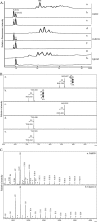Unraveling unique structure and biosynthesis pathway of N-linked glycans in human fungal pathogen Cryptococcus neoformans by glycomics analysis
- PMID: 22500028
- PMCID: PMC3365987
- DOI: 10.1074/jbc.M112.354209
Unraveling unique structure and biosynthesis pathway of N-linked glycans in human fungal pathogen Cryptococcus neoformans by glycomics analysis
Erratum in
- J Biol Chem. 2013 Oct 4;288(40):28950
Abstract
The encapsulated fungal pathogen Cryptococcus neoformans causes cryptococcosis in immunocompromised individuals. Although cell surface mannoproteins have been implicated in C. neoformans pathogenicity, the structure of N-linked glycans assembled on mannoproteins has not yet been elucidated. By analyzing oligosaccharide profiles combined with exoglycosidase treatment, we report here that C. neoformans has serotype-specific high mannose-type N-glycans with or without a β1,2-xylose residue, which is attached to the trimannosyl core of N-glycans. Interestingly, the neutral N-glycans of serotypes A and D were shown to contain a xylose residue, whereas those of serotype B appeared to be much shorter and devoid of a xylose residue. Moreover, analysis of the C. neoformans uxs1Δ mutant demonstrated that UDP-xylose is utilized as a donor sugar in N-glycan biosynthesis. We also constructed and analyzed a set of C. neoformans mutant strains lacking genes putatively assigned to the reconstructed N-glycan biosynthesis pathway. It was shown that the outer chain of N-glycan is initiated by CnOch1p with addition of an α1,6-mannose residue and then subsequently extended by CnMnn2p with multiple additions of α1,2-mannose residues. Finally, comparative analysis of acidic N-glycans from wild-type, Cnoch1Δ, Cnmnn2Δ, and Cnuxs1Δ strains strongly indicated the presence of xylose phosphate attached to mannose residues in the core and outer region of N-glycans. Our data present the first report on the unique structure and biosynthesis pathway of N-glycans in C. neoformans.
Figures








References
-
- Perfect J. R. (2005) Cryptococcus neoformans. A sugar-coated killer with designer genes. FEMS Immunol. Med. Microbiol. 45, 395–404 - PubMed
-
- Kwon-Chung K. J., Boekhout T., Fell J. W., Díaz M. (2002) Proposal to conserve the name Cryptococcus gattii against C. hondurianus and C. bacillisporus (Basidiomycota, Hymenomycetes, Tremellomycetidae). Taxon 51, 804–806
-
- Mansour M. K., Latz E., Levitz S. M. (2006) Cryptococcus neoformans glycoantigens are captured by multiple lectin receptors and presented by dendritic cells. J. Immunol. 176, 3053–3061 - PubMed
Publication types
MeSH terms
Substances
LinkOut - more resources
Full Text Sources

